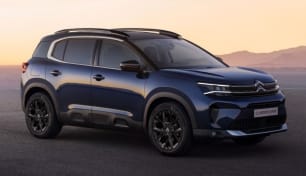There are some particularly strange things about the HS’s cabin when it comes to practicality.
The seats are perhaps the biggest issue. Not only are they clad in a cheap feeling vinyl, but the seating position is very high, and you hardly sink into the seat base, leaving you with the impression you’re sitting on the car rather than in it. Weird.
Visibility is great out the sides of this car, but with the seating position the way it is, I feel like my head is close to the roof and the windscreen has a narrow letterbox aspect. This is complicated further by the rear vision mirror, which sticks a fair way down into your field of view.
The front of the cabin feels plenty wide enough, though, and there are some other practicality wins, like the multimedia screen which is easily within reach.
Its limited resolution is a benefit here, with the touch elements being big and easy to reach while you’re concentrating on the road, but the stock software is clumsily laid out and slow, taking a full second or two to react to some interactions.
This is especially notable as the entire climate system is operated via the touchscreen.
The cabin offers up decent storage. There are big bottle holders in the doors as part of a larger bin, and there are a further two large bottle holders in the centre console with a removable divider.
The armrest box opens to reveal a small storage area, which also has an internal vent for the air-conditioning.
Under the shortcut buttons up front there’s a flip-open tray with two USB outlets and a 12V port, but this little opening is so tiny it’s no good to store any kind of object. It’s also impossible to close the flip cover if you have something plugged in.
The rear seat is one of the HS’s best attributes. Compared to even the front seats, the rear passenger space is enormous, with ample width, headroom, and legroom.
The seats can recline slightly, and amenities are even impressive with two pockets on the backs of the front seats, large bottle holders in the doors, dual adjustable air vents, and two USB ports for rear passengers.
Of special note is the strangely lavish drop-down centre armrest, which is clad in soft trim and has a flip-open tray and dual bottle holders.
Rear seat space comes at a bit of a cost to boot capacity, though. The HS offers 451 litres, which is a little off-the-pace for the mid-size SUV segment. The rear seats intrude into the space a fair bit, and the floor is quite high.
It fit our three-piece CarsGuide luggage set, but only just, and it required removing the retractable luggage cover. Unlike the top-spec Essence, the Excite does not have a power tailgate.
No spare wheel in +EV versions of the HS, with the underfloor space housing a repair kit and a small cutaway for charging paraphernalia.

